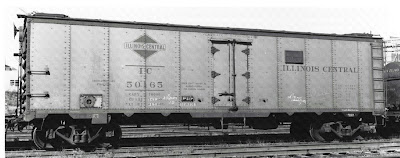Awhile back I bought a model at a swap meet, an Athearn metal reefer nicely built up. This was obviously an event that took place a long time ago, because the car has Mantua couplers, not often seen in the hobby since the 1950s. It has an attractive paint scheme, so I decided to try and find out more about it, in particular, whether I could use it as you see it. This quest turned out to be an interesting example of how information can be pursued, which is why I’m reporting it.
I quickly learned that the paint scheme shown is the way the cars were delivered, with the green stripe at top and bottom of the yellow car sides, green side lettering, and aluminum roof. Side sill tabs and ends are black. The model has black ice hatch covers and running board, and at least the ice hatches should definitely be aluminum also. The new cars had placard boards and route card boards, and since these were also yellow originally, their outlines are printed on the Athearn sides.
I had a recollection that the roofs were later repainted, and I knew that there had been discussion among freight car people as to whether the ends originally were the same green as the side lettering. The consensus, back in the last century, was that the ends were indeed green. I can illustrate that point:
My late friend Richard Hendrickson maintained a file box of 3 x 5-inch cards, on which he wrote down information he could find about groups of cars on many railroads. I inherited this file, and here is his entry for these IC reefers. He does state that ends were green. Note that at the bottom he states that by 1948, roofs were black or dark green.
Since my model doesn’t have trucks like this, I immediately thought of replacing them. But before I got underway with that idea, luckily I was directed by George to the Illinois Central’s diagram for these cars, as you see below. (You can click on the image to enlarge it if you wish.)
In the lower right corner, you will note the listing for trucks. Cars 50200–50299 did indeed have Type B trucks, as the builder photo shows, but the preceding 200 cars did not. My model, lettered as IC 50037, should have ASF double-truss trucks. The existing trucks are not an unacceptable version of that. By the way, this diagram reflects early 1950s revisions, by which time the cars had been retrofitted with Preco fans.
But what about the debate on end color? Opinions continued to differ, until Bill Kelly sent me copies he had made of the Illinois Central stenciling diagram on the internet. I really appreciate his generosity. Though not high resolution images, they do illustrate all the main points. I show an overall view below.
Here is Bill Kelly’s list of the paint colors from this drawing:
Roof - Aluminum
Moulding & Trimming - Black
Underframe - Black
Ends - Black
Sides - Yellow P.P.G. Co. 29-16
Door - Yellow P.P.G. Co. 29-16
Side Sill - Green P.P.G. Co. 29-23
Side Sill Reinfororcement - Black
Stencilling:
Green on Yellow
White on Green & Black
This seems to settle the question of correct colors for these cars, as originally built. My model does have black ends, and I could paint all the roof parts aluminum. But then I would have a 1937 car, not really appropriate for my 1953 modeling year. For the appearance in later years, I would have to add fans and paint the roof and placard boards black. Not only that, but the IC emblem and reporting marks were moved to the right to clear the fans. Below is an in-service view, also from George Corral, showing this appearance, with the obviously retrofitted fan control.
I am not yet sure what I want to do. Perhaps correcting the car for 1937 and putting it in my display case would be a good move. I already have an IC reefer in my operating fleet and don’t really need more. (I might add fans to that car.) But I enjoyed learning about the history of these cars, which is why you’re reading this report.
Tony Thompson






Finally! I can begin painting now. I think!
ReplyDelete